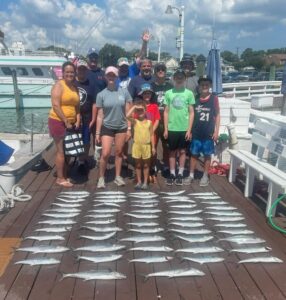
Spaniards. Spanish Mackerel. They’re well up into Bay waters and if they see a Clarke Spoon, they’ll eat it.
I can remember about 30 years ago when Spanish first began to poke their snouts up into the Chesapeake Bay. Before that, they stayed in the ocean – mostly to our south. Today, the mackerel make an early appearance in the Bay and head well past Deltaville and Sting Ray Point.
Currently, Spanish mackerel schools are scattered along the oceanfront to Cape Henry and into the bay, all the way to Reedville. With shifting winds recently, the water temperature has been fluctuating wildly from day to day. Anglers are trolling Drone and Clark spoons behind line sinkers or planers to land catches like the one above.
Huge schools of red drum have been surfacing daily in the lower Bay. So long as no one spooks them, some days angers can sight cast them for hours.
Cobia are throughout the bay, but the lower bay is still the best location. Bucktails have been working well for the sight casters but having a live eel or croaker at the ready is a good plan.
Flounder fishing is good. Lots of fish in the 4-pound range have been caught near the CBBT, the Cell and around wrecks. Inshore ocean wrecks have also been good spots for the flounder.
There are lots of sheepshead in the lower bay, especially around the CBBT. Most anglers choose to use fiddler crabs, but cut crab, sand fleas, and fresh clam will do the trick.
Tautog are often caught while fishing for sheepshead. Tautogs must be a minimum of 16 inches to keep.
Spadefish are hanging around the CBBT, ocean buoys and the Light Tower. Anglers float fresh clam morsels on small hooks. If they are not aggressively feeding, try putting some chum in the water.
Topwater baits have been productive for speckled trout on shallow grassy flats. Popping corks with shrimp type baits, and small swim baits work well. They also draw strikes from puppy drum and rockfish.
Ocean structures are holding flounder, spadefish, and sea bass. The deeper wrecks hold seabass, tilefish, and grouper. Amberjacks are all around the towers.
The bluewater boats are bringing in yellowfin tuna, blackfin tuna, big eye tuna, and mahi. White marlin releases are on the rise.
OBX
Sunday was the day to be on the piers. Big schools of drum were hanging all around the piers. Spike, the rod repairman at TW’s Tackle, was able to catch one from the Nags Head pier that morning. There were also reports of tarpon, cobia, king mackerel. sea mullet, sheepshead, and bluefish caught from the piers.
Surf fishing has been good for sea mullet early in the morning. Make sure you’re not casting too far out, or you’ll likely miss them. There have been a few puppy drum, croaker, bluefish, and plenty of sharks in the surf.
Inshore fishing is still productive with lots of trout, sheepshead, and drum. We heard reports of some big bluefish caught down near the Oregon Inlet bridge.
It has been a bit rough to go offshore, but when the boats have been able to make it, they are catching dolphin, yellowfins, and sailfish. There have been a few blue marlin caught and released as well.
Freshwater
Hot weather and low water conditions sum up the freshwater report. It’s tough going on the rivers. Lake water temps are also high and heavy boat traffic makes things worse.
Hopefully, some mid-week rains will make things better. The tidal rivers – the Chick, Potomac, and James – remain the best bets.

